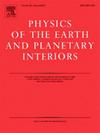从横波分裂推断的东喜马拉雅地幔流的变化
IF 1.9
3区 地球科学
Q2 GEOCHEMISTRY & GEOPHYSICS
引用次数: 0
摘要
本研究试图通过岩心折射相的横波分裂分析来了解东喜马拉雅下地幔的变形模式。在使用的83个宽带地震台站中,有70个台站的数据是首次进行分析。这包括沿着喜马拉雅**两条剖面新部署的21个监测站,以填补以前研究中使用的监测站的空白。在本研究中总共获得了172个约束良好的新分裂和215个零测量。平均延迟时间值为0.64和0。在西部(不丹喜马拉雅和**喜马拉雅西部)和东部(**喜马拉雅中部到东部),快速极化方位角的方向有系统的变化。在这两个段中,快速极化方位角的取向主要从NE-SW或/和ENE-WSW,到E-W,从西到东。在不丹喜马拉雅的西部和中部,不能排除软流圈地幔中绝对板块运动相关应变的影响,而在不丹喜马拉雅的东部和**喜马拉雅,方位角各向异性可以用板块回滚导致的弧形平行地幔流来解释。此外,在**喜马拉雅中部的少量观测表明,沿NNE-SSW方向的延迟时间略大,可能与地幔楔流有关。喜马拉雅**的东部可能与**和缅甸弧平行的排斥性弧流有关,导致无效测量。不丹和**喜马拉雅各向异性的最佳深度分别在220 ~ 270 km和200 ~ 240 km左右,表明各向异性的来源在软流圈的上部。本文章由计算机程序翻译,如有差异,请以英文原文为准。

Variations in mantle flow beneath the Eastern Himalaya inferred from shear wave splitting
This study attempts to understand the upper mantle deformation patterns beneath the Eastern Himalaya by performing shear wave splitting analysis of core-refracted phases. Out of the 83 broadband seismic stations used, data from 70 stations are analysed for the first time. This includes 21 stations which were newly deployed along two profiles in Arunachal Himalaya, to fill the gaps in the stations used for previous studies. In total, 172 well constrained new splitting and 215 null measurements are obtained in this study. Average delay time values of 0.64 and 0.76 s in the Bhutan and Arunachal Himalaya respectively, suggest weak anisotropy, probably due to a steep subduction of the Indian mantle lithosphere. There is a systematic variation in the orientation of fast polarization azimuths in the western (Bhutan Himalaya and western part of Arunachal Himalaya) and eastern segments (central to the eastern part of Arunachal Himalaya). In both these segments, the orientation of fast polarization azimuths varies dominantly from NE-SW or/and ENE-WSW, to E-W, from west to east. In the western and central parts of Bhutan Himalaya, the influence of absolute plate motion related strain in the asthenospheric mantle cannot be ruled out, while in its eastern part and Arunachal Himalaya, the azimuthal anisotropy can be explained by arc parallel mantle flow due to slab rollback. In addition, a few observations in the central part of Arunachal Himalaya indicate a slightly larger delay time, along NNE-SSW, which could be associated with mantle wedge flow. The eastern part of Arunachal Himalaya might be associated with a repulsive arc parallel flow from the Arunachal and Burmese arcs, resulting in null measurements. The optimal depth of anisotropy in Bhutan and Arunachal Himalaya is around and km respectively, suggesting that the source of anisotropy lies in the upper part of the asthenosphere.
求助全文
通过发布文献求助,成功后即可免费获取论文全文。
去求助
来源期刊

Physics of the Earth and Planetary Interiors
地学天文-地球化学与地球物理
CiteScore
5.00
自引率
4.30%
发文量
78
审稿时长
18.5 weeks
期刊介绍:
Launched in 1968 to fill the need for an international journal in the field of planetary physics, geodesy and geophysics, Physics of the Earth and Planetary Interiors has now grown to become important reading matter for all geophysicists. It is the only journal to be entirely devoted to the physical and chemical processes of planetary interiors.
Original research papers, review articles, short communications and book reviews are all published on a regular basis; and from time to time special issues of the journal are devoted to the publication of the proceedings of symposia and congresses which the editors feel will be of particular interest to the reader.
 求助内容:
求助内容: 应助结果提醒方式:
应助结果提醒方式:


